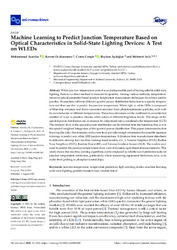Machine learning to predict junction temperature based on optical characteristics in solid-state lighting devices: A test on WLEDs
| dc.contributor.author | Azarifar, Mohammad | |
| dc.contributor.author | Ocaksönmez, Kerem | |
| dc.contributor.author | Cengiz, Ceren | |
| dc.contributor.author | Aydoğan, Reyhan | |
| dc.contributor.author | Arık, Mehmet | |
| dc.date.accessioned | 2023-06-16T08:08:59Z | |
| dc.date.available | 2023-06-16T08:08:59Z | |
| dc.date.issued | 2022-08 | |
| dc.identifier.issn | 2072-666X | en_US |
| dc.identifier.uri | http://hdl.handle.net/10679/8424 | |
| dc.identifier.uri | https://www.mdpi.com/2072-666X/13/8/1245 | |
| dc.description.abstract | While junction temperature control is an indispensable part of having reliable solid-state lighting, there is no direct method to measure its quantity. Among various methods, temperature-sensitive optical parameter-based junction temperature measurement techniques have been used in practice. Researchers calibrate different spectral power distribution behaviors to a specific temperature and then use that to predict the junction temperature. White light in white LEDs is composed of blue chip emission and down-converted emission from photoluminescent particles, each with its own behavior at different temperatures. These two emissions can be combined in an unlimited number of ways to produce diverse white colors at different brightness levels. The shape of the spectral power distribution can, in essence, be compressed into a correlated color temperature (CCT). The intensity level of the spectral power distribution can be inferred from the luminous flux as it is the special weighted integration of the spectral power distribution. This paper demonstrates that knowing the color characteristics and power level provide enough information for possible regressor trainings to predict any white LED junction temperature. A database from manufacturer datasheets is utilized to develop four machine learning-based models, viz., k-Nearest Neighbor (KNN), Radius Near Neighbors (RNN), Random Forest (RF), and Extreme Gradient Booster (XGB). The models were used to predict the junction temperatures from a set of dynamic opto-thermal measurements. This study shows that machine learning algorithms can be employed as reliable novel prediction tools for junction temperature estimation, particularly where measuring equipment limitations exist, as in wafer-level probing or phosphor-coated chips. | en_US |
| dc.description.sponsorship | EVATEG Center ; Ozyegin University | |
| dc.language.iso | eng | en_US |
| dc.publisher | MDPI | en_US |
| dc.relation.isformatof | Micromachines | |
| dc.relation.ispartof | Micromachines | |
| dc.rights | Attribution 4.0 International | * |
| dc.rights | openAccess | |
| dc.rights.uri | http://creativecommons.org/licenses/by/4.0/ | * |
| dc.title | Machine learning to predict junction temperature based on optical characteristics in solid-state lighting devices: A test on WLEDs | en_US |
| dc.type | Article | en_US |
| dc.description.version | Publisher version | en_US |
| dc.peerreviewed | yes | en_US |
| dc.publicationstatus | Published | en_US |
| dc.contributor.department | Özyeğin University | |
| dc.contributor.authorID | (ORCID 0000-0002-5260-9999 & YÖK ID 145578) Aydoğan, Reyhan | |
| dc.contributor.authorID | (ORCID 0000-0002-9505-281X & YÖK ID 124782) Arık, Mehmet | |
| dc.contributor.ozuauthor | Aydoğan, Reyhan | |
| dc.contributor.ozuauthor | Arık, Mehmet | |
| dc.identifier.volume | 13 | en_US |
| dc.identifier.issue | 8 | en_US |
| dc.identifier.wos | WOS:000845363900001 | |
| dc.identifier.doi | 10.3390/mi13081245 | en_US |
| dc.subject.keywords | Gradient boosted trees | en_US |
| dc.subject.keywords | Junction temperature | en_US |
| dc.subject.keywords | Light emitting diodes | en_US |
| dc.subject.keywords | Machine learning | en_US |
| dc.subject.keywords | Random forest | en_US |
| dc.subject.keywords | Solid-state lighting | en_US |
| dc.subject.keywords | Emperature prediction | en_US |
| dc.identifier.scopus | SCOPUS:2-s2.0-85137601773 | |
| dc.contributor.ozugradstudent | Azarifar, Mohammad | |
| dc.contributor.ozugradstudent | Cengiz, Ceren | |
| dc.relation.publicationcategory | Article - International Refereed Journal - Institutional Academic Staff, Undergraduate Student, Graduate Student and PhD Student |
Files in this item
This item appears in the following Collection(s)
Share this page




